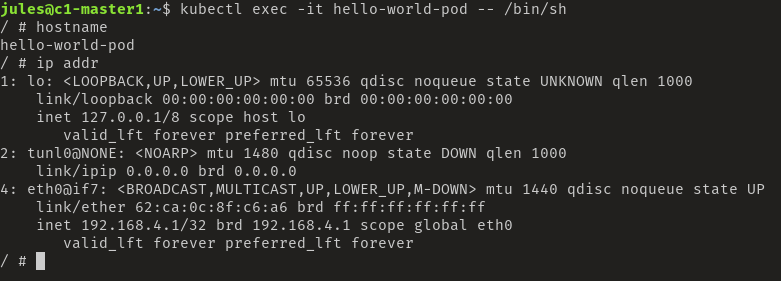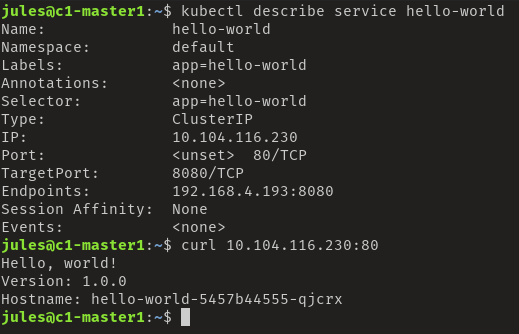Application deployment
Imperative configuration
La configuration imperative, s'execute une ligne de commande après l'autre. Créant ainsi un objet après l'autre.
kubectl create deployment nginx --image=nginx
La commande passe par "l'API Server", un objet est crée. Mais en ligne de commande seul un ibjet à la fois peut être utilisé.
kubectl run nginx --image=nginx
Cela créer un pod en utilisant nginx.
Cela permet de gérer le cluster, mais devient difficile si l'architecture ou l'applications se complexifie.
Example Côté Master
Creation d'un déploiement nommé "hello-world", le conteneur est simplement un serveur web affichant "Hello World"
kubectl create deployment hello-world --image=gcr.io/google-samples/hello-app:1.0

Il est temps de déployer un pod
kubectl run hello-world-pod --image=gcr.io/google-samples/hello-app:1.0
Et de regarder le résultat
kubectl get pod
Ici nous avons bien nos 2 pods déployé

kubectl get deployment
kubectl get pods -o wide

Example Côté Node
Il est intéressant de voir comment les conteneurs ont été généré dans les nodes
bash
ssh jules@c1-node1
sudo docker ps

Regarder les logs
Il est intéressant de regarder les logs provenant de cette manipulation
kubectl log hello-world-pod

Exec in a container
Il est possible comme avec Docker de se connecter à un conteneur
kubectl exec -it hello-world-pod -- /bin/sh

Détail du déploiement
Ces commandes permettent de regarder l'état actuel du déploiement
kubectl get deployments.apps hello-world
kubectl get replicasets.apps
kubectl get pods
Tous est UP et dans le "desired state"
# Take a closer look at our application using: describe
kubectl describe deployments.apps hello-world
kubectl describe pods hello-world-5457b44555-qjcrx
#But the service is not expose, let's do it
kubectl expose deployment hello-world --port=80 --target-port=8080
Maintenant que le service est exposé, il est possible de regarder le résultat
kubectl get service hello-world

#More precise information about the service
kubectl describe service hello-world
#Test the container
curl http://10.104.116.230:80

#List all the endpoint of a service
kubectl get endpoints hello-world
En faisant la requête curl sur l'IP et le port de la commande "get endpoints", nous outrepassons le service de load balancer en accédant au pod directement. Pratique pour le débug, mais pas pour la prod.
Declarative configuration
Nous définissons l'état désiré dans le code
A travers des manifest, nous pouvons d'écrire l'état dans lequel nous voulons que l'architecture soit maintenue.
Ces manifest peuvent être écrit en JSON ou YAML et être donné à "l'API Server" via
kubectl apply -f deployment.yaml
Nous récupérons la configuration de notre service précédemment installé.
#Using kubectl to generate yaml or json files of our imperitive configuration.
kubectl get service hello-world -o yaml
kubectl get service hello-world -o json
WARNING: "--export is deprecated" nous verrons plus loin comment générer de nouveaux ces fichiers
#Save theses info for a redeployment
kubectl get service hello-world -o yaml --export > service-hello-world.yaml
kubectl get deployment hello-world -o yaml --export > deployment-hello-world.yaml
#We can ask the API for more information about an object
kubectl explain service | more
#And drill down further if needed, includes very good explanation of what's available for that resource
kubectl explain service.spec | more
kubectl explain service.spec.ports
kubectl explain service.spec.ports.targetPort
Supprimons les instances créer précédemment
kubectl delete service hello-world
kubectl delete deployment hello-world
kubectl delete pod hello-world-pod
kubectl get all

Création du déploiement
#Deploying applications declarativly and store in the file (this command DON'T lauch the deployment)
kubectl create deployment hello-world \
--image=gcr.io/google-samples/hello-app:1.0 \
--dry-run=client -o yaml > deployment-hello-world.yaml
cat deployment-hello-world.yaml
#Apply deployment from the file created above
kubectl apply -f deployment-hello-world.yaml
Idem pour le service
#Expose the service from the deployment
kubectl expose deployment hello-world \
--port=80 --target-port=8080 \
--dry-run=client -o yaml > service-hello-world.yaml
cat service-hello-world.yaml
#If the file already exists
kubectl apply -f service-hello-world.yaml
Grace à ce système de fichier, il est possible de changer directement la configuration d'un déploiement
#scale up our deployment
nano deployment-hello-world.yaml
Change replicas from 1 to 2
replicas: 2
#Apply the changes
kubectl apply -f deployment-hello-world.yaml
#Check it
kubectl get deployment hello-world

Il est alors possible de tester le load balancer en répétant la requête curl
#Repeat the curl access to see the load balancing of the HTTP request
kubectl get service hello-world
curl http://$SERVICEIP:80
Il est également possible modifier "on the fly" la configuration
kubectl edit deployment hello-world
#The deployment is scaled to 3 and we have three pods
kubectl get deployment hello-world
kubectl get pods
#Let's clean up our deployment and remove everything
kubectl delete deployment hello-world
kubectl delete service hello-world
kubectl get all